This guide explains requirements in the ADA Standards for stairways.
Notational tips for users of screen reading software follow. In this document ″ indicates inches and ′ indicates feet. Some images are paired with visually hidden notes. These annotations are prefaced with begin and end image notes.
Required Compliance
[§210]
Interior and exterior stairs that are part of a required means of egress must meet the Standards. Compliance is required for all stairs on required egress routes, including those comprised of a single riser. The Standards do not apply to stairways that are not part of a required means of egress nor to alternating tread devices and “ship’s ladders.” The Standards exempt aisle stairs in assembly areas, stairs in non-public areas of detention and correctional facilities, and stairs of play components.
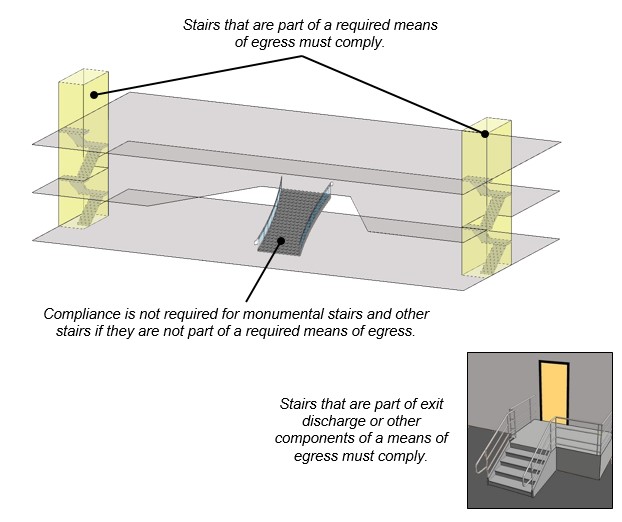
Alterations
In alterations, stairs between levels that are connected by an accessible route (e.g., ramp or elevator) are not required to meet the Standards, but handrails must comply when stairs that are part of a means of egress are altered (§210.1, Ex. 2).
Stairways
[§504]
Requirements for stairways address treads and risers, surfaces, nosings, and handrails.
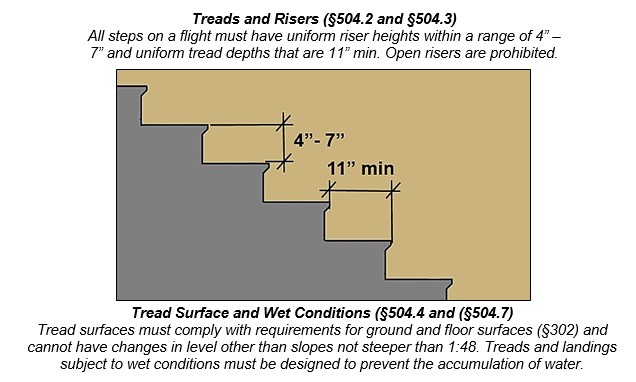
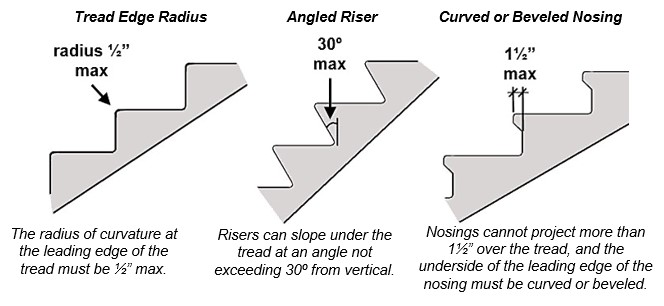
Handrails
[§504.6]
Handrails are required on both sides of stairs and must be continuous within the full length of each stair flight. Inside handrails on switchback or dogleg stairs must be continuous.
Stairway Handrails
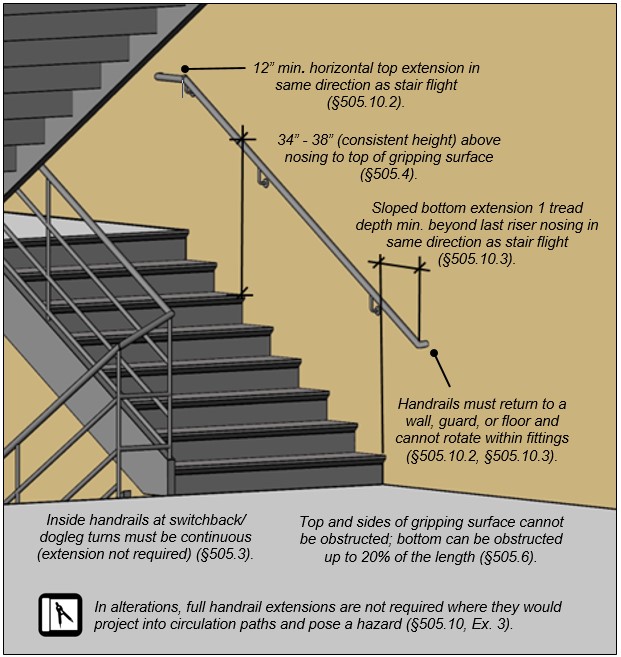
Handrail Extensions
[§505.10]
Handrail extensions at the top and bottom must return to walls, guards, or floors and horizontal portions must comply as protruding objects. The length is measured to the start of the return radius.
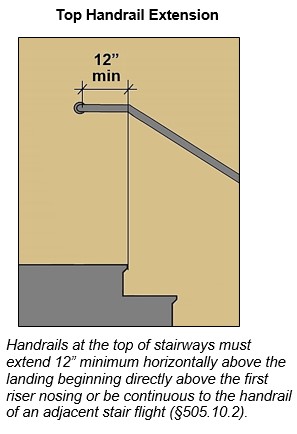
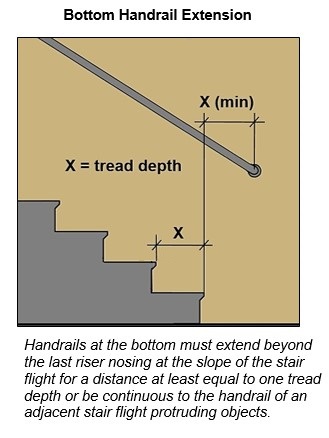
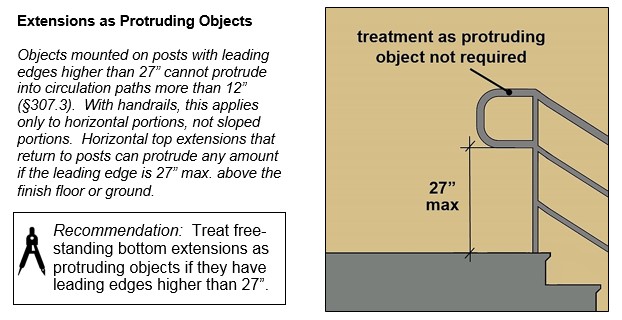
Handrail Clearance and Cross Section
[§505.5]
Surface requirements and clearances facilitate a power grip along the length of handrails. Handrails can have circular or non-circular cross-sections, but must have rounded edges. The gripping surface and adjacent surfaces must be free of abrasive or sharp elements. Wall-mounted handrails with leading edges higher than 27″ cannot protrude more than 4½″ into circulation paths (§307.2).
Circular Cross Section and Clearance
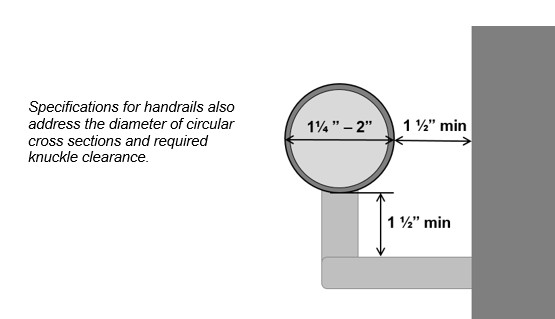
Non-Circular Cross Section and Clearance
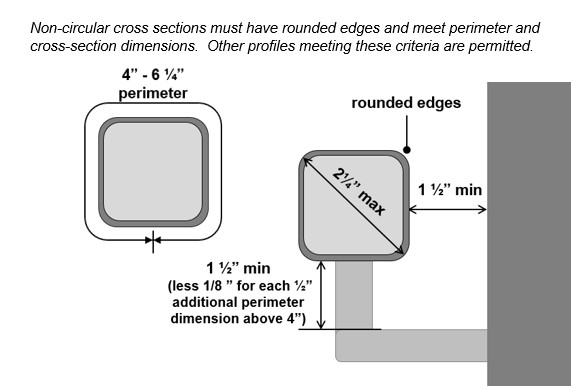
Escalators
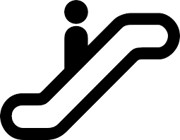
The ADA Standards address escalators in rail and fixed guideway stations (§810.9) but not those provided in other types of facilities. Escalators must have a clear width of at least 32 inches and meet specific provisions in the ASME A17.1 Safety Code for Elevators and Escalators. The referenced ASME criteria require steps to be demarcated by yellow lines 2 inches wide maximum along the back and sides (§6.1.3.5.6) and specify at least 2, but no more than 4, flat steps at escalator entrances and exits (§6.1.3.6.5).
Common Questions

Are stairs that are not part of means of egress required to comply with the Standards?
No, interior or exterior stairs that are not part of a required means of egress do not have to meet the Standards.
Are exterior stairs required to comply with the Standards?
The Standards apply to both exterior and interior stairs that are part of a required means of egress. This includes exterior stairs that are part of exit discharge (i.e., the path from an exit to a public way such as a street or alley).
Is there a minimum number of risers a stairway must have for it to be covered?
No, the Standards apply to any stairs that are part of a means of egress regardless of the number of risers.
Are stairs in residential dwelling units covered by the Standards required to comply?
Yes, stairs that are part of a means of egress must comply in mobility accessible residential dwelling units covered by the Standards. Egress stairs of residential facilities that are located outside individual dwelling units also must comply.
Can stair treads and risers be perforated?
Stair treads must meet requirements for floor or ground surfaces which specify that surface openings not allow passage of a sphere more than ½ inch in diameter (§302.3). Risers cannot be open, but perforations or openings in riser surfaces that prohibit passage of a sphere not more than ½ inch in diameter are acceptable.
Can handrail extensions wrap or turn?
Handrail extensions must be in the same direction as the stair flight, but continuous handrails can wrap at the inside turn of switchback or dogleg stairways. In alterations where the required extension would project into circulation paths and pose a hazard, they can turn, wrap, or be shortened as necessary.
Can handrails overlap door maneuvering clearances?
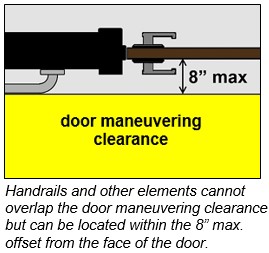
No, door maneuvering clearances must be free of any overlapping objects, even those providing knee and toe clearance, which can interfere with maneuvering at doors and doorways. However, door maneuvering clearances can be offset up to 8″ from the face of the door or gate to accommodate wall thickness, casework, shelves, or other elements adjacent to doorways, including handrails. The door maneuvering clearance must be measured from the leading edge of such elements so that the full clearance is free of any obstruction.
Can handrails be attached to guard rails?
Yes, handrails can be installed on guard rails if all applicable requirements are met.
Is a center handrail required at wide stairways?
No, a center handrail at stairs is not required by the Standards. If a center handrail is provided, compliance with the handrail specifications, while advisable, is not required.
Is color contrast required for stair nosings?
Visual contrast on stair nosings or the leading edges of treads is helpful for people with low vision, but it is not required by the Standards except at escalators in rail and fixed guideway stations which must meet the ASME A17.1 Safety Code for Elevators and Escalators. The ASME A17.1 code requires escalator steps to be demarcated by yellow lines 2″ wide maximum along the back and sides.
Can guards or collars be attached to handrails to prevent skateboard traffic?
No, handrail gripping surfaces at egress stairs subject to the Standards must be unobstructed on the top and sides and free of sharp or abrasive elements so that users can maintain a continuous grip along the full length (§505.6 and §505.8).




